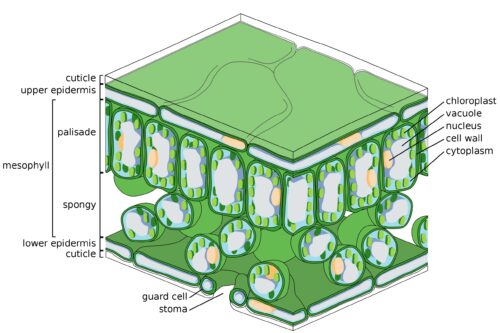Image Courtesy of Wikimedia Commons.
Picture a leaf: the image that comes to mind may be a rounded, green shape with lines running through it. But how did the leaf come to be? This imagery may be intuitive, but the development of the leaf itself has long eluded scientists. However, an interdisciplinary team of Yale researchers composed of biologists and physicists recently determined how a unique and niche structure, the spongy mesophyll, plays a crucial role in developing the structure of the leaves. Specifically, they explored how the movement of plant cells follows a transition from spherical, tightly-packed cells in early development to loose, porous networks in later stages while maintaining their mechanical stability.
The team chose to explore the spongy mesophyll, which is the tissue that exists between the leaf top and the leaf bottom, because of its important role in performing photosynthesis. From a biological perspective, this material is extremely important in carbon sequestration. As sunlight hits the top of the leaf, carbon from the atmosphere is absorbed through the bottom layer. Once those processes happen, the light and carbon dioxide molecules react with the chloroplasts in the cells of the spongy mesophyll. This, in turn, creates glucose for the plant to provide them with energy to continue to grow. “So, from a plant biology perspective, this tissue is super important because it’s like a combination of the lungs and the stomach of the plant,” said John D. Treado, a physicist and lead researcher of the project.
However, instead of focusing on the biological function, this study instead pivoted toward how the spongy mesophyll maintains its mechanical integrity. Unlike animals, whose cells can move around while the animal is still developing, plants can develop only through cell division and cell growth with no mobile cells. From a physical perspective, plant cells have a fundamental constraint on how they are able to grow. Furthermore, the cells grow in a densely packed manner. However, observational images and computer simulations of the spongy mesophyll revealed that it actually grows in a different way. “The tissue looks basically like a sponge,” Treado said. There are rather large spaces between the cells, which makes the tissue very porous rather than densely packed. How could this be sustained?
To figure out this question, the team created computer simulations and varied different parameters to see which simulations were most similar to the images they collected of the mesophyll. They implemented certain growth rules based on deformable polygons that can change their shape in response to different stressors placed on them. As more pressure was placed on the cells, the boundary relaxed and expanded in response, which is how the network of mesophyll cells grows while keeping its overall formation. They found that the robust generation of pore space was due to a unique balance of the parameters of cell growth, adhesion, stiffness, and tissue pressure. The lack of contact with other cell boundaries made growth and remodeling of the cell wall possible. Additionally, cells needed to use the cell-cell adhesive strength to build networks and make sure that those networks did not bend too much, but rather formed rigidly. Thirdly, the pressure inside the boundary must be constant throughout. All this demonstrates that a complex, unique tissue such as the spongy mesophyll can be assembled through simple mechanical rules.
The significance of studying spongy mesophyll is rooted in its exciting applications for climate science and environmental engineering. Not only does this tissue allow plants to capture the energy they need to grow further through photosynthesis, but it also provides a key substance needed for other organisms to continue growing and provide more life—oxygen. “The reason the atmosphere is so oxygen-rich is because life evolved this ability, millions of years ago, to convert the carbon dioxide in the atmosphere to oxygen,” Treado said. “All of the other organisms that were evolving at the same time realized that they could breathe the oxygen that was created by the plant.” In the future, the spongy mesophyll has the potential to advance research on creating synthetic plant tissues to help with carbon sequestration. Perhaps, instead of only envisioning a leaf, scientists may be able to create one too.

